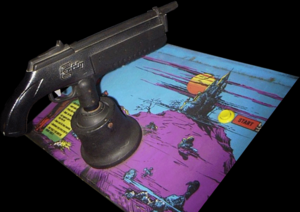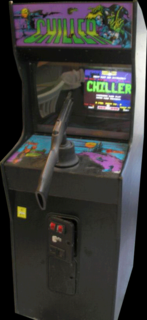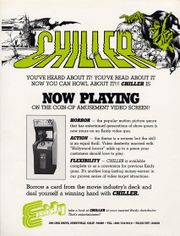Lost In Translation/Chiller
| Chiller | |
|---|---|
| Manufacturer | Exidy |
| Released | 1986 |
| Control Method |
Lightgun 1 Button(s) |
| Main CPU | M6809 (@ 1.622 MHz) M6809 (@ 811.200 kHz) |
| Sound CPU | Stereo Custom (@ 50.700 kHz) |
| Video Details |
Raster (Horizontal) 320 x 240 pixels 60.00 Hz 256 Palette colours |
| Screens | 1 |
| ROM Info | 53 ROMs 358,656 bytes (350.25 KiB) |
| MAME ID | chiller |
About The Game
Chiller is a lightgun based, arcade video game consisting of four different screens (plus two different bonus screens). The object is simply to shoot everything in sight (and to try and locate any hidden targets on the screen). The game is based on time, and the timer moves faster when you are shooting poorly.
The first screen is a torture chamber. There are four (still living) human targets on this screen. From left to right they are; a man chained to the wall, a person in a guillotine (shoot the top of the guillotine to decapitate them), a woman strapped in a strange machine, and a man in a head vise (shoot the vise to crush his head). The rest of the room is strewn with blood and loose body parts. You don't simply shoot each target once, instead you shoot each part of the target, which reduces that part to a mess of blood and bones. This is thankfully the most disturbing level in the game.
The second room is another torture chamber with a river of blood flowing through the middle. This one has five human targets; a man strapped to a board, a man chained to the floor, two people on stretching racks (shoot the wheels to pull them apart), and a woman hung from rope over the river (shoot a pulley to slowly lower her into the river to be eaten by crocodiles). Body parts will flow down the river randomly, and a man will pop out of a door from time to time to toss a blade into one of the helpless victims.
The third level is a haunted house hallway. There is only one human victim on this level. It is a woman who runs from one doorway to another, shoot out the trapdoor to cause her to fall inside (and then shoot the beast that was chasing her). Your other targets are mostly assorted ghosts, and a few random body parts that will fall from the ceiling.
The final level is a graveyard. Your only human victim on this level is a woman who is half buried in the ground, shooting her torso multiple times strips off her clothing until she is topless, and the last shot kills her. Your other targets are bats, hands that pop up from the ground, and a man who pulls a cart full of body parts (you can't kill him, shooting him just makes him run away, only to return later).
The game repeats the levels over and over again until you manage to find every secret target on each screen (it gives you hints inbetween levels). Finding all the targets on a single screen earns you a bonus game (a slot machine), while finding all the hidden targets in the game gives you the second bonus game (a shooting gallery), and a free game.
Trivia
So you think blood and guts in video games is a phenomenon of the 90's? The main point of this game is to shoot helpless humans in the most gory manner possible. It is amazing that this game somehow slipped past the watchdogs back in 1986.
This game was available as either a dedicated cabinet or a a conversion kit for other Exidy gun games (which used the same cabinet anyway). The marquee had a green 'Chiller' logo on a purple nighttime background (it looks like the title screen to a cheap horror movie). The control panel overlay has similar graphics (and game instructions), along with pictures of various body parts. The game is controlled by a large optical gun that is fixed to the control panel where it can only fire into the machine. The monitor itself was hidden deep inside the machine, the gameplay was displayed on a mirror.
Staff
- Software/Graphics
- Larry Hutcherson
- Vic Tolomei
- Ken Nicholson
- Hardware
- Howell Ivy
- Audio
- Ken Nicholson
Cabinet and Artwork
Ports
- Consoles
- Nintendo Famicom (1986)






